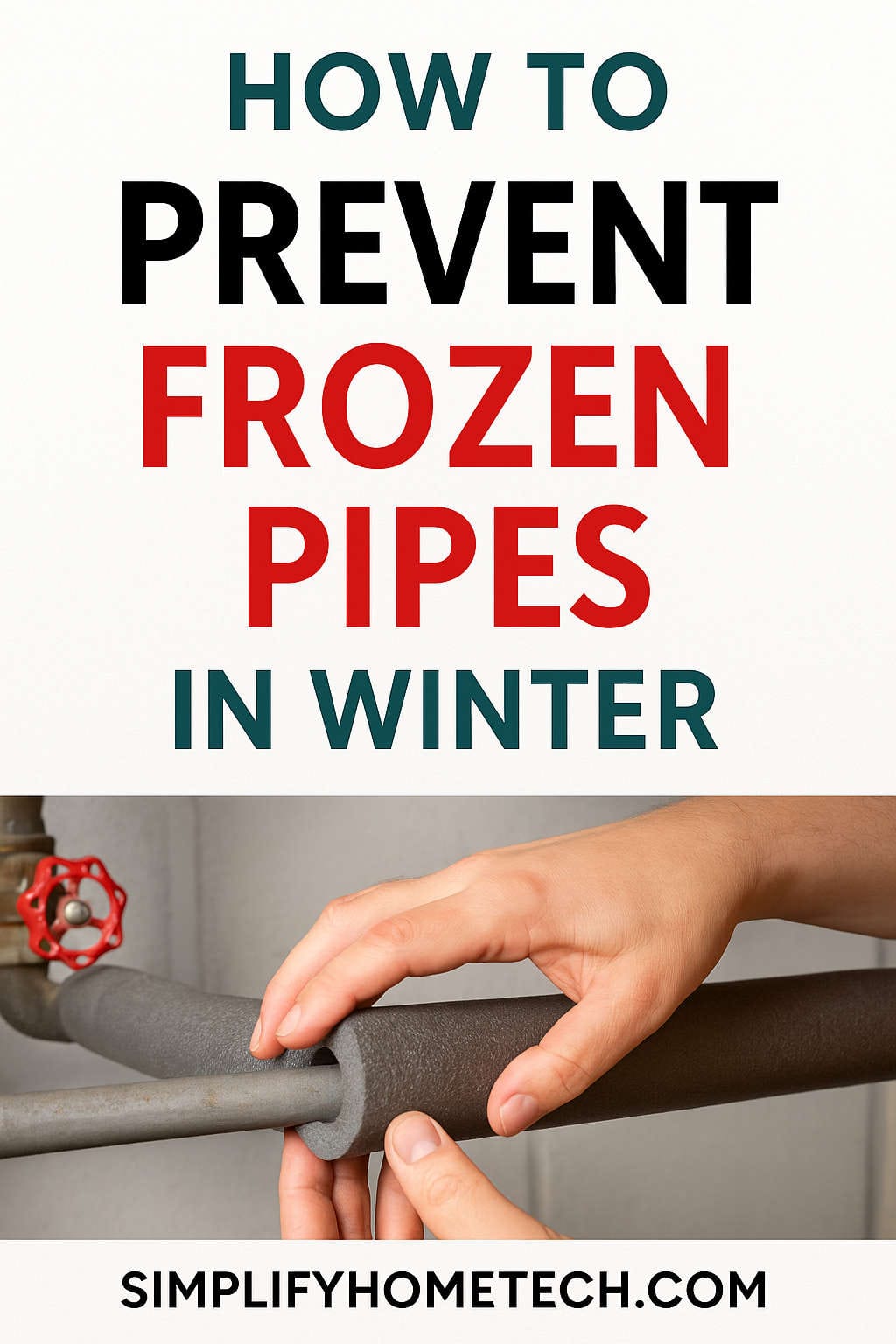Winter can be magical—cozy fires, snowflakes drifting down, hot cocoa—but it can also bring a cold reality: frozen pipes. If you’ve ever dealt with the chaos of a burst pipe, you already know how stressful (and expensive) it can be. The good news is, this is a preventable disaster.
This guide isn’t just about quick tips—it’s a complete guide to understanding why pipes freeze, how to stop it from happening, and what to do if you catch it too late. Whether you’re a homeowner, a renter, or managing a seasonal cabin, these tips will help you keep your water flowing and your winter stress-free.
Why Frozen Pipes Are a Big Deal
Let’s start with the basics. Pipes freeze when the temperature around them drops below 32°F (0°C). This is especially dangerous for plumbing that isn’t properly insulated or located in unheated spaces like basements, attics, crawlspaces, and exterior walls.
But the real problem isn’t just the freezing—it’s what happens when the frozen water expands. This expansion creates pressure inside the pipe, which can cause it to crack or burst. Once the ice melts, you’re left with leaking water that can cause major damage to your walls, floors, and belongings.
A single burst pipe can cause thousands of dollars in repairs. According to the Insurance Institute for Business & Home Safety, water damage from frozen pipes is among the most common winter insurance claims.
So if you’re wondering whether you should worry about frozen pipes—yes, you absolutely should. But with a little preparation, you can avoid the headache altogether.
What Makes Some Pipes Freeze More Easily?
Not all pipes are equally vulnerable. Here are some of the most at-risk locations and types of pipes:
- Outdoor faucets and hose bibs
- Pipes in unheated interior spaces, like garages, basements, and crawlspaces
- Plumbing in exterior walls that don’t have enough insulation
- Cabins or seasonal homes that are unoccupied in the winter
- Under-sink pipes in kitchens or bathrooms located against outside walls
If you can locate these risk zones in your home now, you’re one step closer to avoiding a disaster.
Signs That a Pipe May Be Frozen
Sometimes you won’t know your pipes are in trouble until they burst—but there are warning signs. Here’s what to look for:
- No water or a weak trickle from a faucet that normally flows well
- Frost on the outside of exposed pipes
- Bulging or deformed pipes, especially around joints
- Unusual smells coming from your faucets or drains (due to blockage)
- Banging or gurgling sounds in the walls when you turn on the water
If you suspect a frozen pipe, act quickly. The longer it stays frozen, the higher the risk of it bursting.
Step-by-Step: How to Prevent Frozen Pipes Before Winter Hits
Let’s get into the heart of it—how to prevent frozen pipes. These steps are worth every bit of effort, especially if your area is prone to sub-freezing temperatures.
1. Insulate, Insulate, Insulate
If there’s one thing you should prioritize, it’s insulation. You can buy inexpensive foam pipe sleeves at any hardware store. They’re easy to install and effective.
- Wrap exposed pipes in unheated areas (basements, garages, crawlspaces).
- Pay special attention to pipes near exterior walls.
- Use fiberglass or foam insulation for long runs of piping.
- Don’t forget to insulate hot water lines as well—it saves energy too.
You can also find pipe heating cables or heat tape that plugs in and keeps pipes warm automatically. These are great for notoriously cold spots and are especially useful in older homes.
2. Seal Up Drafts and Gaps
Cold air sneaking into your home can quickly freeze pipes. Take a weekend and go on a draft-hunting mission.
- Use caulk or spray foam to seal gaps around pipe holes, vents, electrical wiring, and foundation cracks.
- Add weatherstripping to doors and windows.
- If your basement or crawlspace has vents, close them during the coldest months to keep warm air inside.
Even small leaks can lead to significant heat loss and frozen plumbing.
3. Disconnect and Drain Outdoor Hoses
This is one of the simplest, most overlooked steps—and one of the most important.
- Disconnect garden hoses from all outdoor spigots.
- Drain any water from the hose and store it indoors.
- If possible, shut off the water supply to outdoor faucets from the inside and drain the pipe.
For added protection, install frost-proof spigots, which are designed to keep water away from the cold exterior.
4. Add Insulation to Vulnerable Spaces
It’s not just your pipes that need insulation—your home does too.
- Insulate your attic to prevent cold air from seeping down into your walls and ceiling.
- Lay down vapor barriers and insulation board in crawlspaces.
- Cover exposed foundation walls with foam panels or insulation blankets.
This not only protects your plumbing—it improves your home’s energy efficiency and comfort.
5. Check and Maintain Your Heating System
A broken furnace in the middle of a cold snap is a disaster waiting to happen.
- Get your HVAC system professionally serviced before winter.
- Change furnace filters regularly so warm air can circulate freely.
- Consider installing a smart thermostat so you can monitor temperatures even when you’re away.
If your heat suddenly fails, your pipes are on a timer before they start freezing.
What to Do During Extreme Cold
When the mercury drops below 20°F (-6°C), your pipes need extra protection—even if you’ve done all the prep work. Here’s how to respond during cold snaps:
Keep Faucets Dripping
Let a small stream of water run from both the hot and cold taps. It doesn’t need to be a steady flow—just enough to keep water moving. Running water is much less likely to freeze.
Focus on faucets connected to at-risk pipes, especially in bathrooms or kitchens near exterior walls.
Open Cabinet Doors
This trick is simple but highly effective. Opening cabinet doors under your sinks lets warm air from your house reach the pipes.
Pro tip: If you have pets or small children, make sure cleaning products inside those cabinets are moved out of reach.
Keep Interior Doors Open
Encourage even airflow by keeping bedroom and bathroom doors open. Warm air should circulate throughout the house, not get trapped in one room.
Don’t Turn Down the Heat at Night
Many people lower the thermostat overnight to save money—but during severe cold, that can be risky. Keep your home consistently warm (at least 55°F or 13°C) day and night.
Leaving for Vacation? Here’s How to Winter-Proof Your Pipes
If you’re heading out of town for a few days (or weeks), here’s what to do before you leave:
- Shut off the main water valve to your home. This stops water from flowing into your pipes at all.
- Drain the system by opening all faucets and flushing toilets until no water remains.
- Leave the heat on at no lower than 55°F (even if no one is home).
- Open cabinet doors under sinks to allow warm air to circulate.
- Consider a smart thermostat or leak detector so you can monitor the situation remotely.
If it’s a second home or a seasonal property, using non-toxic RV antifreeze in your drains and toilets is also a good idea.
What to Do If You Think a Pipe Has Frozen
Even with all the preparation, things can go wrong. If you turn on the faucet and nothing comes out—or only a trickle—it’s time to act fast.
Step 1: Keep the Faucet Open
Leave the affected faucet on. As you begin to thaw the pipe, water will start to flow again. This also helps relieve pressure inside the pipe.
Step 2: Locate the Frozen Section
Start with the most vulnerable areas—look for pipes along exterior walls or in unheated spaces. Feel along the pipe for cold spots, frost buildup, or swelling.
Step 3: Apply Gentle Heat
Use one of the following methods to slowly warm the frozen pipe:
- A hair dryer (best tool for tight spaces)
- A heating pad wrapped around the pipe
- Warm towels soaked in hot water
- A portable space heater (placed safely nearby)
Never use an open flame, blowtorch, or propane heater. These are fire hazards and can damage the pipe.
Step 4: Check for Leaks
Once the pipe thaws and water flows again, check for cracks or leaks. Even a tiny split can lead to serious damage later. If you find one, turn off the water supply immediately and call a plumber.
Long-Term Upgrades to Consider
If you’re repeatedly battling frozen pipes each winter, it may be time for a bigger investment. Here are some long-term solutions that can pay off:
- Reroute plumbing away from exterior walls or unheated areas.
- Upgrade to PEX piping, which is more freeze-resistant than copper or PVC.
- Install frost-free hose bibs on the exterior of your home.
- Use a whole-house smart leak detection system to get alerts before damage occurs.
- Add permanent pipe heating systems in crawlspaces or basements.
Yes, these upgrades cost money—but when compared to repairing burst pipes, water damage, and mold remediation, they’re often the cheaper choice in the long run.
Quick Recap: Winter Pipe Protection Checklist
Here’s a handy recap of all the prevention steps you can take:
✅ Insulate exposed pipes
✅ Seal air leaks and drafts
✅ Disconnect and drain outdoor hoses
✅ Insulate crawlspaces and attics
✅ Keep heat consistent inside the home
✅ Let faucets drip during deep freezes
✅ Open cabinet doors near plumbing
✅ Leave the heat on when away
✅ Monitor your home with smart tech
Final Thoughts
Frozen pipes might not seem like a big deal—until they burst and flood your home. But the truth is, you don’t need to be a plumber or spend a fortune to protect your home.
With a few supplies, some proactive maintenance, and a little common sense, you can keep your pipes safe and your winter peaceful. Don’t wait until the first freeze to act—start preparing now, and thank yourself later when your water runs freely all season long.
Got a frozen pipe story or tip to share? Let’s hear it in the comments! And if you found this guide helpful, share it with your neighbors—they’ll appreciate it more than you know.
Stay warm, stay safe, and here’s to a winter with no plumbing disasters.
You might also like,
- How to Flush a Water Heater Step-by-Step (DIY Guide for Homeowners)
- How to Fix Low Water Pressure in Your Home: Simple DIY Solutions That Work
- Top 10 Plumbing Maintenance Tips for 2025 | Save Money & Prevent Problems
- Choosing the Right Water Heater for Your Home: Everything You Need to Know
- Understanding Gas Control Valves in Water Heaters: Complete Troubleshooting & Repair Guide

